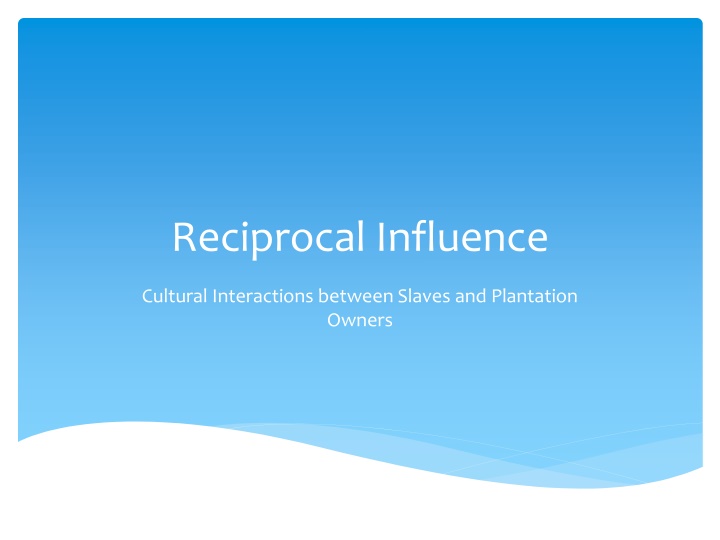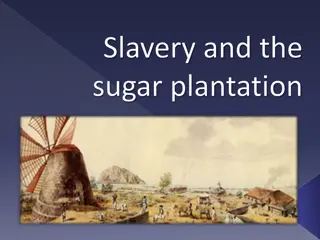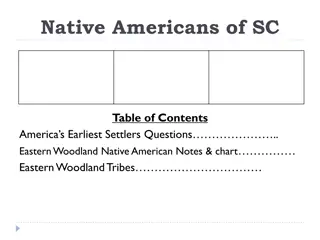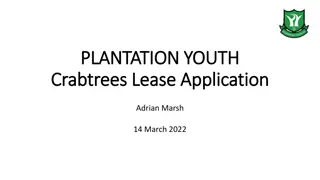Cultural Interactions Between Slaves and Plantation Owners in South Carolina
Enslaved and free Africans played a significant role in shaping the culture and economy of the South and South Carolina. The growth of the slave trade led to a population imbalance between African and European settlers. African contributions to agricultural development were essential, while resistance to slavery, exemplified by the Stono Rebellion, led to the enactment of laws to control slaves. The Middle Passage highlights the harrowing journey many Africans endured. Slaves provided inexpensive labor for crops like rice, indigo, and later cotton. Despite their enslavement, Africans brought diverse cultural backgrounds, knowledge, and skills to North America, shaping a unique cultural amalgamation.
Download Presentation

Please find below an Image/Link to download the presentation.
The content on the website is provided AS IS for your information and personal use only. It may not be sold, licensed, or shared on other websites without obtaining consent from the author.If you encounter any issues during the download, it is possible that the publisher has removed the file from their server.
You are allowed to download the files provided on this website for personal or commercial use, subject to the condition that they are used lawfully. All files are the property of their respective owners.
The content on the website is provided AS IS for your information and personal use only. It may not be sold, licensed, or shared on other websites without obtaining consent from the author.
E N D
Presentation Transcript
Reciprocal Influence Cultural Interactions between Slaves and Plantation Owners
8-1.4 - Explain the significance of enslaved and free Africans in the developing culture and economy of the South and South Carolina, including the growth of the slave trade and resulting population imbalance between African and European settlers; African contributions to agricultural development; and resistance to slavery, including the Stono Rebellion and subsequent laws to control slaves. Triangular Trade Origins of slavery in SC Many slaves were brought from Barbados Majority of slaves were forced on the Middle Passage from the West coast of Africa and then sold on the auction block.
The Middle Passage Facts: 10 to 16 million Africans were transported across the Atlantic to the Americas between 1500- 1800 At least 2 million died during the Middle Passage Horrific living conditions, lack of food/water, poor sanitary conditions.
Impacts Economy: slaves provided an inexpensive and reliable source of labor which SC relied on for their experience in the plantation system. Rice, indigo, naval stores and later cotton were labor intensive crops which required many slaves.
Impacts African slaves greatly outnumbered white settlers in SC and attempted several revolts once slavery became too cruel. Stono Rebellion Slave Codes
Slaves were not always slaves! Came from distinct culture, heritage, tradition, and language Over 800 different ethnic and language groups in Africa Came to N. American colonies with specialized knowledge and skills Different regions of Africa, like N. America, were better suited to different types of agriculture Different regions therefore had different foods Different regions and groups had their own distinct customs, mores, and folkways
What does it all mean? Africans came to N. America with their own culture, heritage, traditions, and customs To Plantation owners, they came with special skills and knowledge Different groups were forced to live together after relocation African culture in N. America became an amalgam of hundreds of different backgrounds Africans brought with them: Foods, Music, and Specialized Knowledge & Skills This meant that Africans from certain regions were more desirable to plantation owners growing specific goods, could fetch higher prices at auction because of their origins and knowledge (Increased value to owners) ie. The Grain Coast brought Africans with specific knowledge of rice cultivation
Different Types of Slaves Laborers Slaves that would toil in the fields, from sun up to sun down, performing grueling manual labor, as long as the weather was not to severe Farmers Slaves with specialized knowledge and skills that could be more effectively used in cultivation Cooks Usually worked in the Big house, cooked for the owner and the family, learned to cook white food, but had African ingredients and style (Infusion) House Slaves Slaves, usually females and children, that performed work in the house for the owner and family Musicians Had normal work duties, would play for slaves at end of the day, highly sought after, played for owners at many events, had more freedoms, could earn extra money
Plantations were not always Plantations Several varieties of Plantation: Rice, Indigo, Tobacco, Cotton Different regions in the N. American colonies better suited to different types of agriculture Many farms started off very small and only grew over time In many cases, slaves and owners would live together, eat together, and sleep together South Carolina well suited for the cultivation of rice along the coast and its many islands
South Carolina Rice Plantations Well suited for the growing of rice Problem! Most colonists and Europeans did not know how to properly plant, grow, and harvest rice They were taught how to do it; by whom? African slaves purchased from the Grain Coast of Africa had incredible knowledge of rice production Most came from Western and Central Africa, Sierra Leone and other areas South Carolina shared many commonalities with these regions of Africa (Temperature and Conditions)
Slave & Owner Interactions Most farms began small with slave and owner living and working together Mixing of culture Isolation was a constant problem; lack of transportation means and methods, mainly by water but also with some pack animals Limited number of partners for slaves Slaves held on tightly to traditions and customs, brought music, food, and knowledge
Slave Population in South Carolina Year Number of slaves Total population Percentage Of Population Enslaved 1708 3,000 9,500 31.5 percent Slave population rose as production of rice rose 1724 32,000 46,000 69.5 percent 1750 39,000 64,000 60.9 percent Slaves brought to S.C. in mass numbers, came from certain regions of Africa (particularly Western Africa) 1760 57,253 76,000 75 percent 1765 90,000 130,000 69.2 percent 1790 107,094 249,073 42 percent 1800 149,338 345,591 42.1 percent 1810 196,365 415,115 46.1 percent 1820 258,475 502,741 50.2 percent 1830 315,401 581,185 53.9 percent
Africans Came with Knowledge Colonists had little to no knowledge of how to cultivate rice Africans brought knowledge of rice cultivation, taught colonists how Knew specialized ways of clearing, irrigating, and planting Adapted African ways of doing things to N. American bondage
Importance of Origins The origins of Africans made a difference to plantation owners Windward & Rice Coast was an important point of origin
West Coast of Africa Western & Central Africa shares similar climate and conditions with South Carolina Africans came with knowledge of rice cultivation, irrigation, and foods Slaves knowledge of rice and different ways of preparing it, was extremely important in connecting cultures 1850s Georgetown County, SC was Western World s top rice producer
Infusion of Food African culinary traditions mixed with white food; slaves were the cooks for the owners and while they learned how to cook white food, many mixed in African influences
Africans Music more than perhaps any other aspect of African culture, music survived the ordeal of the Middle Passage to play a significant role in the lives of American slaves and contribute greatly to indigenous forms of American music. (Boles) Slave musicians were highly prized and sought after Often given extra freedoms Could earn extra money (Had to split it with the owner) Brought slave community together
Africans Music Continued Music helped in fields Kept up moral Music taught lessons Helped socialize people Music taught heritage Kept traditions Music taught history Oral tradition Music conveyed messages Including secret ones
Solomon Northup Free Black & Skilled Musician Captured and sold into slavery His music helped: bring slaves together get through difficult times reminded them that they were still human got him through his time as a slave
The Lost Society The Gullah Sweetgrass baskets came from Africa, but had to be modified because of different resources The Gullah of South Carolina & Georgia Isolation along with perseverance helped the Gullah people preserve their own culture, customs, & ways Held on to much of their heritage and culture, infused it with their American environment
Culture Slaves brought their African culture with them to SC. Knowledge of cattle herding, growing rice. Gullah including: language, music, dance, wood carving, folk medicine, and religion.
Current Rice Plantations www.Middletonplace.org Charleston, SC Rice Plantation www.Mansfieldplantation.com Georgetown, SC Rice Plantation www.Hopsewee.com Georgetown, SC Rice Plantation http://www.sc-heritagecorridor.org S.C. State wide heritage
What You Get!! Free Stuff! Entire Lesson Plan SC 8th Grade Standard/Indicator Powerpoint Presentation Companion to Lesson Plan Worksheet Critical Thinking Questions Places that students & teachers can visit Physically and Virtually
Bibliography Boles, John B. Black Southerners 1619-1869. Lexington, KY: University Press of Kentucky , 1984. Cross, Wilbur. Gullah culture in America. Westport, CT: Praeger Publishers, 2008. Davis, David Brion. Inhuman Bondage: The Rise and Fall of Slavery in the New World. New York: Oxford University Press, 2006. Edgar, Walter. South Carolina: A History. Columbia, SC: University of South Carolina Press, 1998. Palmer, Colin A. Passageways: An Interpretive History of Black America Volume 1: 1619-1863. Fort Worth, TX: Harcourt Brace College Publishers, 1998. Smallwood, Arwin D., and Jeffrey M. Elliot. The Atlas of African-American History and Politics: From the Slave Trade to Modern Times. Boston: McGraw- Hill, 1998.























